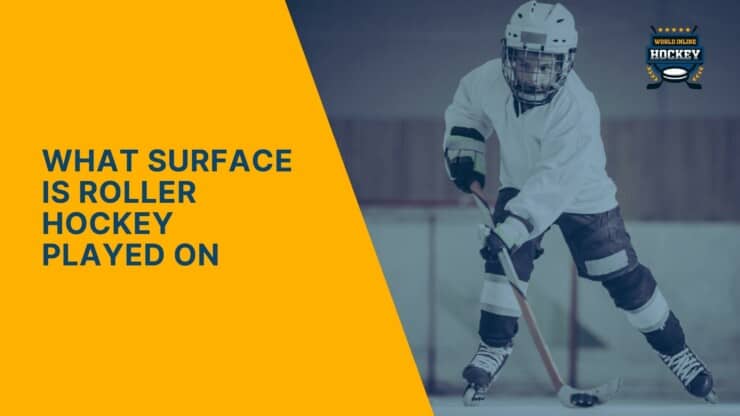What surface is roller hockey played on?
This question often stumps many, even some seasoned players.
The truth is, the surface can make or break your game in roller hockey.
Let’s delve into understanding what surface roller hockey is played on, and how it impacts this thrilling sport.
The Rules and Techniques of Roller Hockey
Roller hockey, a fast-paced team sport played on inline skates or quad roller skate traced elements, requires well-developed skating skills.
It’s not just about speed; agility is also crucial in this game that has its roots intertwined with the traditional roller hockey version.
The Role of Skating Skills in Roller Hockey
In both versions of roller hockey, inline and rink, the importance of proficient skating cannot be overstated.
Mastery over your quad skates or inline skates, depending on which variant you play, significantly contributes to your overall performance during the match.
A player’s ability to swiftly maneuver around opponents while maintaining control over their movement can often make all the difference between winning and losing.
For instance, emphasizes how superior skating techniques allow players to maintain better balance when handling conventional ice hockey sticks.
Physical Training for Roller Hockey
Rigorous physical training plays an integral role in preparing athletes for competitive matches irrespective if it’s hardball hockey or field ball type games.
This includes developing explosive muscle power necessary for quick sprints across the standard ice-like surface used by modern inline international teams under World Skate regulations.
To build endurance needed during extended periods within each round (often comparable with those experienced during a traditional roller game), interval training becomes essential.
a renowned source dedicated towards promoting various forms of puck-based sports including Ice & Inline variants suggests similar exercises designed specifically keeping these requirements mind.
Remember: Despite being played on different surfaces than ice hockey – either smooth concrete/asphalt courts suitable even outdoor settings vs synthetic material resembling real-life frozen water bodies inside indoor arenas – both demand high levels fitness from participants due excellent coordination required amongst teammates along swift movements involved throughout entire duration contests held regularly worldwide sanctioned major governing bodies like IIHF etc.
Roller hockey, a fast-paced team sport played on inline skates or quad roller skate traced elements, requires well-developed skating skills.
It’s not just about speed; agility is also crucial in this game that has its roots intertwined with the traditional roller hockey version.
In both versions of roller hockey – inline and rink – the importance of proficient skating cannot be overstated.
Mastery over your quad skates or inline skates significantly contributes to your overall performance during the match.
A player’s ability to swiftly maneuver around opponents while maintaining control over their movement can often make all the difference between winning and losing.
For instance, superior skating techniques allow players to maintain better balance when handling conventional ice hockey sticks.
FAQs about What Surface is Roller Hockey Played on
What is roller hockey floor made of?
The roller hockey surface can be composed of various materials, including sport court tiles, concrete, asphalt or even wood for indoor rinks.
On which surface is the ice hockey played?
Ice hockey is traditionally played on a smooth and flat sheet of ice in an enclosed rink.
Where is roller hockey most popular?
Roller Hockey enjoys significant popularity in North America and Europe. It’s also gaining traction in countries like Australia and Japan.
What is the difference between roller hockey and ice hockey stick?
Apart from minor variations due to personal preference, there isn’t much difference between sticks used for ice or roller hockey; both typically use standard composite sticks.
Conclusion
In the world of inline hockey, understanding what surface roller hockey is played on can significantly enhance your game. Whether you’re a beginner or an experienced player, it’s essential to know that roller hockey has evolved from its traditional version into a modern sport with distinct features.
The traditional roller hockey game used quad skates – four-wheeled roller skates invented in the 19th century for games like roller polo. This form of play traces elements back to field and ice hockey, employing standard ice rink dimensions for gameplay. The hardball used in this format gave birth to another variant known as hardball or rink hockey.
However, the inception of inline skates brought about significant changes. Modern roller hockey began when players replaced conventional quad skate-traced elements with more streamlined inline ones. Today’s version of this team sport uses an inline international style rather than a ball and is usually conducted on dry surfaces similar to those found in ball or field hockey.
This shift also impacted where and how the game could be played. Unlike ice-based sports such as ice hockey, which requires an icy surface, today’s inline roller hockey can be enjoyed virtually anywhere – from dedicated indoor facilities mimicking standard ice-hockey rinks right down to outdoor concrete courts!
No matter whether you prefer playing quad or inline versions, each offers unique challenges and benefits suited towards different styles of play within this exciting team sport governed by organizations like World Skate and Inline International Hockey Federation.
We hope our blog posts have given you valuable insights into what surface is roller hockey played on. We invite you to continue your journey into the world of inline hockey with us here at World Inline Hockey.

